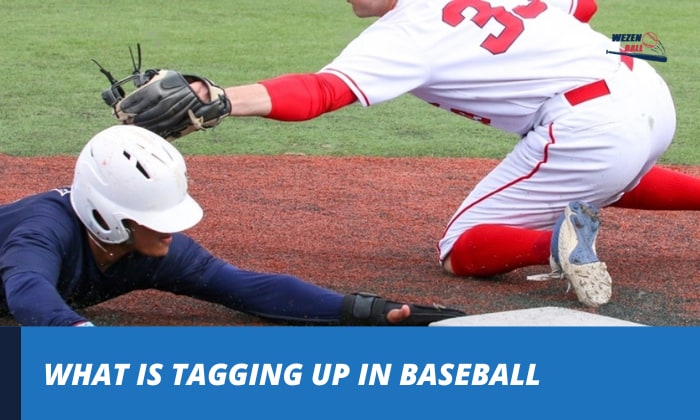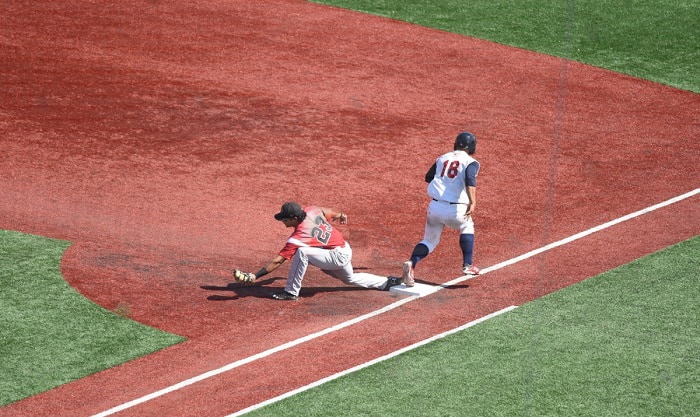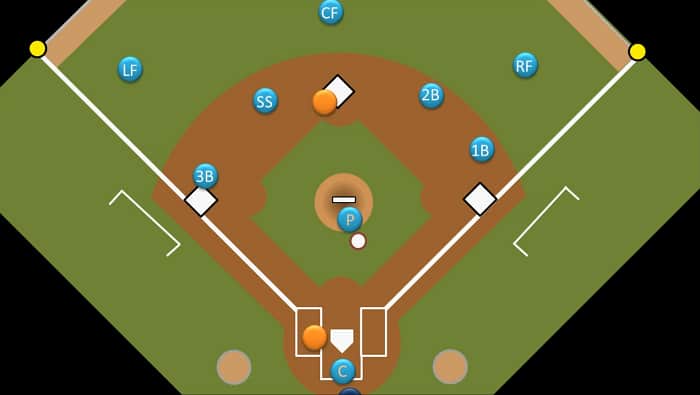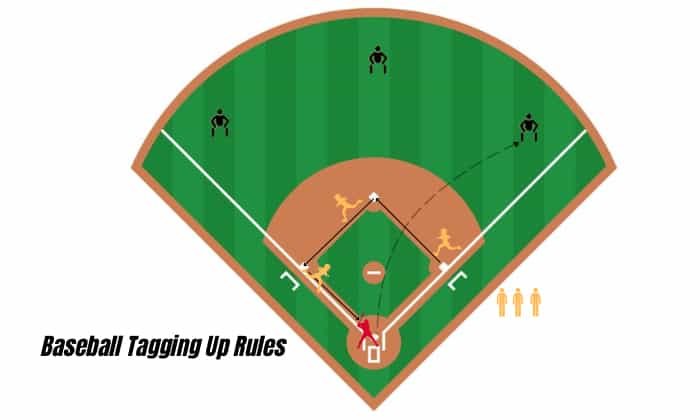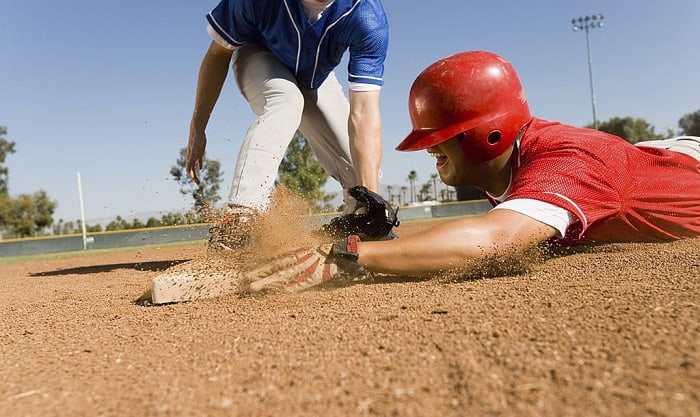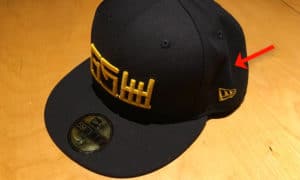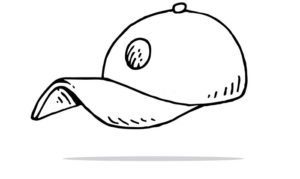Tagging up is a term commonly used in baseball. However, this sounds unfamiliar to casual viewers of the sport.
What is tagging up in baseball? Let’s break it down!
“Tagging up” refers to a baseball action that enables a baserunner to advance toward another base after the opposing team successfully catches a fly ball. The trick, though, is the baserunner has to touch his current base until after the fielder caught the ball before advancing forward to successfully tag up.
Contents
Tagging Up Explained
In baseball, tagging up happens when the baserunner returns to their current and original base after a fly ball is caught by the opposing team’s defenders.
Regardless if the ball is deemed a fair or foul ball, the baserunner has to follow this proposition to avoid being tagged out.
To make tag-up definition simpler, the baserunner always has to retouch his current base if the ball touches any of the fielders.
If they leave early toward the next base without retouching the former base, they will be out; and if they get tagged out, they’re also out.
If any of the situations above happen to a crucial match, it could be costly. That’s why baseball tag-up is utilized as a critical tactic to take advantage of possible scoring opportunities.
Tag Up Baseball Process
Tagging up enables baserunners to move safely to the next base if they so want, without being caught off base in situations where a fly ball is seized by fielders. Here are steps on how to do tagging up in baseball:
1. Observe the situation
When the batter hits a flyball, baserunners are met with a confusing question – is the ball going to be caught or not? If they deem that the answer is yes, then they need to execute tagging up.
2. Returning to the base
If the baserunners have decided that there’s a huge chance that the fielders will catch the ball, they should retreat and retouch their former base.
3. Watch the catch
At this point, baserunners should wait for the outfielder to make the catch after they have reached the starting base then move toward another base when it’s time.
4. Run to the next base
While running toward the next base, baserunners should be wary of their speed and adjust it accordingly with the throw from the outfielders, to avoid being tagged out. If they reach the next base safely, tagging up is successful.
5. Returning to the original base
This step can be made when baserunners feel like they don’t have enough time to continue running forward. It’s legal to do this, given that they touch their original base again.
Baserunners should make sure that the one in front of them would be tagging up, too. If the person in the front does not tag up, it’s not possible to move forward.
Baseball Rules Tagging Up
Tag-up meaning in baseball can be pretty confusing for a lot of different reasons. To simplify, here are the three core rules in attempting to tag up:
- The presence of a runner in a base – this is a given, however, it should be known to all that a batter cannot tag up. When defenders catch a fly ball, the batter is immediately out of the play.
- Less than two outs – when tagging up, there must be less than two outs in the current inning. When outs are already two, the inning ends the moment a defender catches the ball.
- Base-touching when the ball is caught – it doesn’t matter how far along you’ve come, when the ball gets caught, it’s optimal that you touch your former base.
What Happens if a Runner Fails to Tag Out When a Flyball is Caught?
The runner is deemed to have left the base early or failed to tag up if they do not make contact with the base they were standing on when the ball was caught. In such situations, the opposing team has the power to either appeal the play or not.
If the defenders choose to appeal and are successful, the runner will be called out by the umpire. If they do not appeal, then the runner can be considered safe to run toward the next base.
When a runner decides to advance toward another base without tagging up and they get tagged out in the process, they will also be called out. Overall, not tagging up when a flyball is caught will destroy opportunities for baserunners to advance and maybe score a point.
Famous Plays Involving Tagging Up
Here are some of the most famous tag-up meetings that happened in the MLB:
- Pablo Sandoval of the San Francisco Giants
In the World Series 2014 of SF and KC, Pablo Sandoval can be seen tagging up on the flyball Brandon Belt has hit.
The moment a flyball was hit, Sandoval first observed the trajectory of the ball. When he was sure that the defender could catch it, he returned to his former base and touched it.
He ran towards the next base afterwards and made it there before the defenders could tag him out. This is an example of a successful tag-out.
- Jarren Duran of the Boston Red Sox
In this game of BOS versus MIN, Jarren Duran executed a tag-out successfully.
When he saw that a flyball was caught, he immediately performed tagging up and successfully scored from 2nd base after the defenders failed to tag him out of the next bases. He did it so splendidly that other players in the team celebrated after the point.
Tips and Techniques for Tagging Up
1. Tips to determine the time when to tag
The most effective way to tag up is to keenly observe the trajectory of the ball, as well as assess the skills and capacity of players on the mound. Generally, base runners should always wait until the ball touches the fielders before deciding to tag up.
2. Tips for base runners when tagging up
Here are some of the things base runners need to master when tagging up:
- Quick decision making
- Watch where the ball goes and read its trajectory
- Always stay alert and plan out your next moves
- If necessary, slide through the bases to avoid a tag
3. Tips for outfielders when tagging up:
- Read the trajectory of the ball and move immediately
- Position yourself correctly upon waiting to catch the ball. This prepares you to catch the ball correctly.
- Gain momentum upon catching the ball.
- Properly catch the baseball, then do a crow hop to send off the ball.
Frequently Asked Questions
Baseball force out vs tagging up: what’s the difference?
In baseball, tagging up entails returning to a base after a fly ball is caught and touching it with the option of moving on to the next base. For a tag up, the fielder shall touch the runner with the ball, the glove holding the ball while it is in his possession.
Meanwhile, a force out happens when a runner is obliged to advance due to the presence of another runner. For a forceout, a fielder can retire the baserunner from the play by touching the base which the runner was supposed to run toward.
What are some common mistakes players make while tagging up?
Even the best players on the field commit mistakes when a sequence leads to tagging up. Here are some of them:
- Not tagging up – baserunners tend to forget to touch the former base after a flyball is caught.
- Poor timing – players often miscalculate their timing, and leave too early or too late after fly balls are caught.
- Unaware of the play situation – when runners are unaware of the position of outfielders on the field, or the number of outs in an inning, they are susceptible to making wrong decisions upon tagging up.
Conclusion
Tagging up in baseball refers to the situation where a baserunner has to return to his original base after a flyball is caught by the defenders of the opposing team. This is a significant play in baseball that requires awareness, timing, and quick decision-making.
The answer to “What is tagging up in baseball?” can be pretty confusing, but I hope this article was enough to articulate everything you need to learn about this topic.
There are many more topics in store for you! Thanks for reading, and I’ll see you again soon!
Read next: 9 Baseball Positions and Roles

A powerful swing and the ball is flying across the field, just one hit, and we might never forget the thrill it brings. I do not know about you, but I never do. Every baseball game is the chance to compete with others and cooperate with your teammate. It is among my biggest passions.



